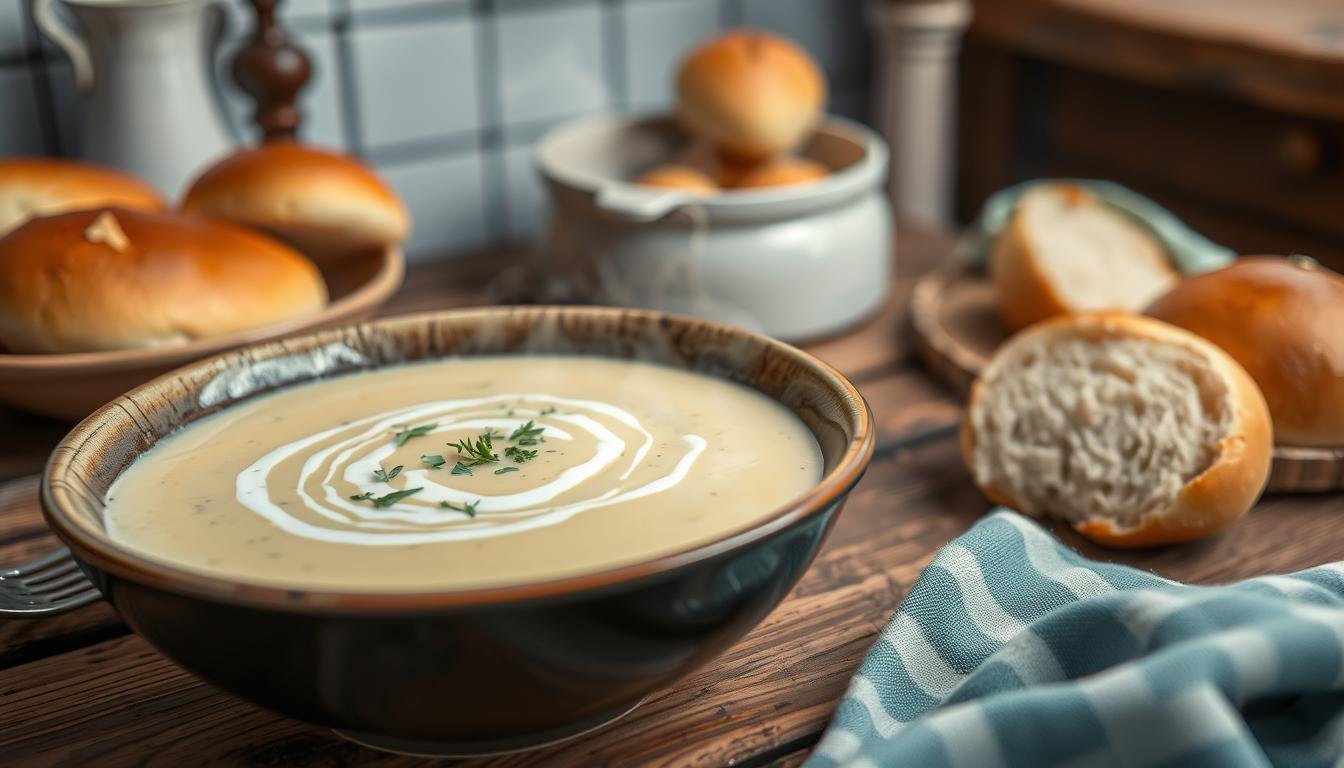Imagine a steaming bowl of creamy potato soup on a cold day. It warms you up inside. This classic dish is a favorite comfort food for many.
Creamy potato soup combines rich flavors with smooth textures. It’s simple to make and can be tailored to your liking. Whether you want a basic recipe or something fancy, there’s a version for you.
We’ll dive into the history, ingredients, and how to make this beloved dish. You’ll learn to create the perfect creamy potato soup at home. Get ready to see why this comfort food enchants people all over the United States.
The History and Appeal of Potato Soup
Potato soup has a long history that spans centuries and continents. It started as a simple meal for peasants and has become a favorite comfort food globally. Let’s dive into its origins and why it’s so popular.
Origins of Potato Soup
In the 16th century, Europe first saw potatoes from the Americas. Peasants quickly made hearty soups with these versatile crops to get through harsh winters. As potatoes spread, each European region made its own version of potato soup.
A Beloved Comfort Food
Now, potato soup is a top comfort food for many. Its creamy texture and warm flavors bring back memories of home. It’s easy to make and customize, making it a hit with families and food lovers.
Cultural Variations
Potato soup has made its way into cuisines worldwide, each with its own spin. In Ireland, colcannon is a creamy soup with kale or cabbage. Germany adds sausage to their potato soup, while France serves vichyssoise chilled. These variations show how the dish adapts to local tastes and ingredients.
Essential Ingredients for the Perfect Creamy Potato Soup
Choosing the right ingredients is key to making a delicious potato puree. For a classic soup, use starchy potatoes like Russets or Yukon Golds. These potatoes are easy to break down, making your soup smooth.
Dairy products are crucial for creaminess. Heavy cream, whole milk, or half-and-half are great choices. If you’re making a vegetarian soup, vegetable broth is a good base. Adding onions, garlic, and celery will enhance the flavor.
Seasonings are important for a great taste. Salt and black pepper are must-haves. Herbs like thyme or rosemary add depth. For a richer flavor, try adding cheese such as cheddar or Parmesan.
Looking to make substitutions? You have many options. For a dairy-free version, use coconut milk or cashew cream. You can also try different vegetables like leeks or carrots for unique flavors.

The quality of your ingredients affects the final taste. Choose fresh produce and high-quality dairy for the best potato puree. With these essentials, you’re ready to make a comforting bowl of creamy potato soup.
Step-by-Step Guide to Making Creamy Potato Soup
Making creamy potato soup is easier than you might think. Just follow this guide to create a comforting bowl of deliciousness. It’s perfect for chilly days.
Preparing Your Ingredients
First, gather your ingredients. You’ll need potatoes, onions, garlic, butter, cream, and broth. Peel and chop the potatoes into small cubes. Dice the onions and mince the garlic. Having everything ready before you start makes cooking smoother.
Cooking Techniques for Maximum Flavor
Start by sautéing the onions and garlic in butter until they’re soft and fragrant. This step builds a flavorful base for your soup. Then, add the potato cubes and broth, and simmer until the potatoes are tender. This method ensures your soup tastes rich.
Blending and Finishing Touches
After cooking the potatoes, it’s time to blend. Use an immersion blender for a smooth consistency, or leave some chunks for texture. Stir in cream to get that creamy potato soup richness. Season with salt and pepper to taste. Garnish with chives or bacon bits for extra flavor and looks.
By following these steps, you’ll make a delicious thick soup that’s sure to impress. Enjoy your homemade creamy potato soup!
Nutritional Benefits of Potato Soup
Potato soup is a great choice for a hearty meal. It’s full of nutrients that help your health. This vegetarian soup is perfect for anyone looking for a nutritious option.
Potatoes are loaded with vitamin C, potassium, and fiber. These help keep your immune system strong, your heart healthy, and your digestion smooth. Adding carrots and celery makes the soup even better, with more vitamins and minerals.
If you’re watching calories, there are ways to make this soup healthier. Use low-fat milk or vegetable broth instead of cream to cut calories. Adding lean meats or plant-based proteins like beans or tofu can also increase the protein content.
Try leaving the potato skin on for extra fiber and nutrients. You can also use different herbs and spices to make it taste great without adding more calories.
Remember, it’s important to watch how much you eat. A bowl of potato soup can be a nutritious and comforting meal. Serve it with a salad or whole-grain bread for a well-rounded meal that tastes good and is good for you.
Creamy Potato Soup Variations: From Classic to Gourmet
Potato bisque is a dish that can be made in many gourmet ways. It goes from classic to vegan, offering something for everyone. Let’s look at some tasty ways to make this meal even better.
Traditional Creamy Potato Soup
The classic potato bisque combines tender potatoes, rich cream, and savory broth. You can add bacon bits, chives, or sharp cheddar cheese for more flavor. This recipe is a great starting point for many gourmet twists.
Loaded Baked Potato Soup
Make your potato soup feel like a loaded baked potato in a bowl. Add crispy bacon, shredded cheese, and sour cream. Finish with green onions for freshness. This rich version is perfect for satisfying your comfort food cravings.
Vegan Creamy Potato Soup Options
For vegan choices, potato bisque can be easily changed. Use coconut milk or cashew cream instead of dairy. Add roasted garlic, nutritional yeast, or smoked paprika for more flavor. These vegan versions show that creamy potato soup can be tasty and dairy-free.
Try different herbs, spices, and toppings to make your own gourmet versions. Whether you like the traditional or vegan recipe, there’s a creamy potato soup out there for you.
Pairing Your Creamy Potato Soup: Sides and Beverages
Creamy potato soup is a great winter warmer. It gets even better with the right sides and drinks. Try dipping it with crusty bread, like rustic sourdough or cheesy garlic bread.
A crisp green salad with tangy vinaigrette also pairs well. It balances the soup’s richness.
For drinks, a light white wine like Sauvignon Blanc or Pinot Grigio is perfect. Their acidity refreshes your palate. Or, go for sparkling water with a lemon twist or hot apple cider for a cozy touch.

Grilled cheese sandwiches are a great side dish. They offer a gooey cheese and crunchy bread contrast to the smooth soup. For something lighter, roasted vegetables like carrots or Brussels sprouts add color and nutrients.
The best pairings make your comfort food experience even better. They don’t overpower your creamy potato soup.
Tips for Storing and Reheating Your Potato Bisque
Enjoying your potato bisque doesn’t have to end after the first meal. With the right storage and reheating tips, you can enjoy it for days. Let’s look at how to keep your bisque fresh and delicious.
Proper Storage Methods
First, let your potato bisque cool to room temperature. Then, pour it into containers that seal tightly. Put it in the fridge within two hours of cooking. It will stay fresh for up to four days there.
If you want to keep it longer, freezing is a good choice.
Reheating Techniques for Best Flavor
When reheating your potato bisque, do it over low heat. Stir it often to avoid burning. Adding a bit of milk or cream can help keep it creamy and flavorful.
Freezing and Thawing Guidelines
Freezing your potato bisque is simple. Use containers made for the freezer and leave some space for it to expand. It can last up to three months in the freezer.
To thaw, put it in the fridge overnight. Then, reheat it slowly, stirring well to mix everything together. With these tips, you’ll always have a warm bowl of potato bisque ready.
FAQ
What is the origin of creamy potato soup?
Creamy potato soup comes from early European cooking, where potatoes were common. It became a favorite comfort food over time. It also got different cultural twists in various countries and areas.
What are the essential ingredients for making a creamy potato soup?
For a classic creamy potato soup, you need potatoes, dairy like milk or cream, onions, garlic, and seasonings. You can change ingredients to fit dietary needs or likes.
How do I achieve the perfect consistency for creamy potato soup?
To get the right thick and creamy texture, cook and blend the potatoes well. Use dairy or plant-based alternatives and adjust the thickness by adding more liquid or blending more. Blending and finishing are key for the perfect texture.
Is creamy potato soup a nutritious option?
Creamy potato soup can be a filling meal, but its nutrition depends on the ingredients. Potatoes offer carbs, fiber, and important vitamins and minerals. For a healthier version, use low-fat dairy or plant-based options and add more veggies.
What are some popular variations of creamy potato soup?
You can make creamy potato soup in many tasty ways. Try loaded baked potato soup with bacon and cheese, vegan creamy potato soup with plant-based milk, or gourmet versions with special flavors and garnishes.
What sides and beverages pair well with creamy potato soup?
Creamy potato soup goes great with crusty bread, fresh salads, and hot tea or coffee. You can also enjoy it with garlic bread, roasted veggies, or a light white wine.
How should I store and reheat leftover creamy potato soup?
Keep leftover potato soup in an airtight container in the fridge for 3-4 days. Reheat it on the stovetop or in the microwave, stirring now and then, until it’s hot. You can also freeze it, but the texture might change a bit when thawed and reheated.






